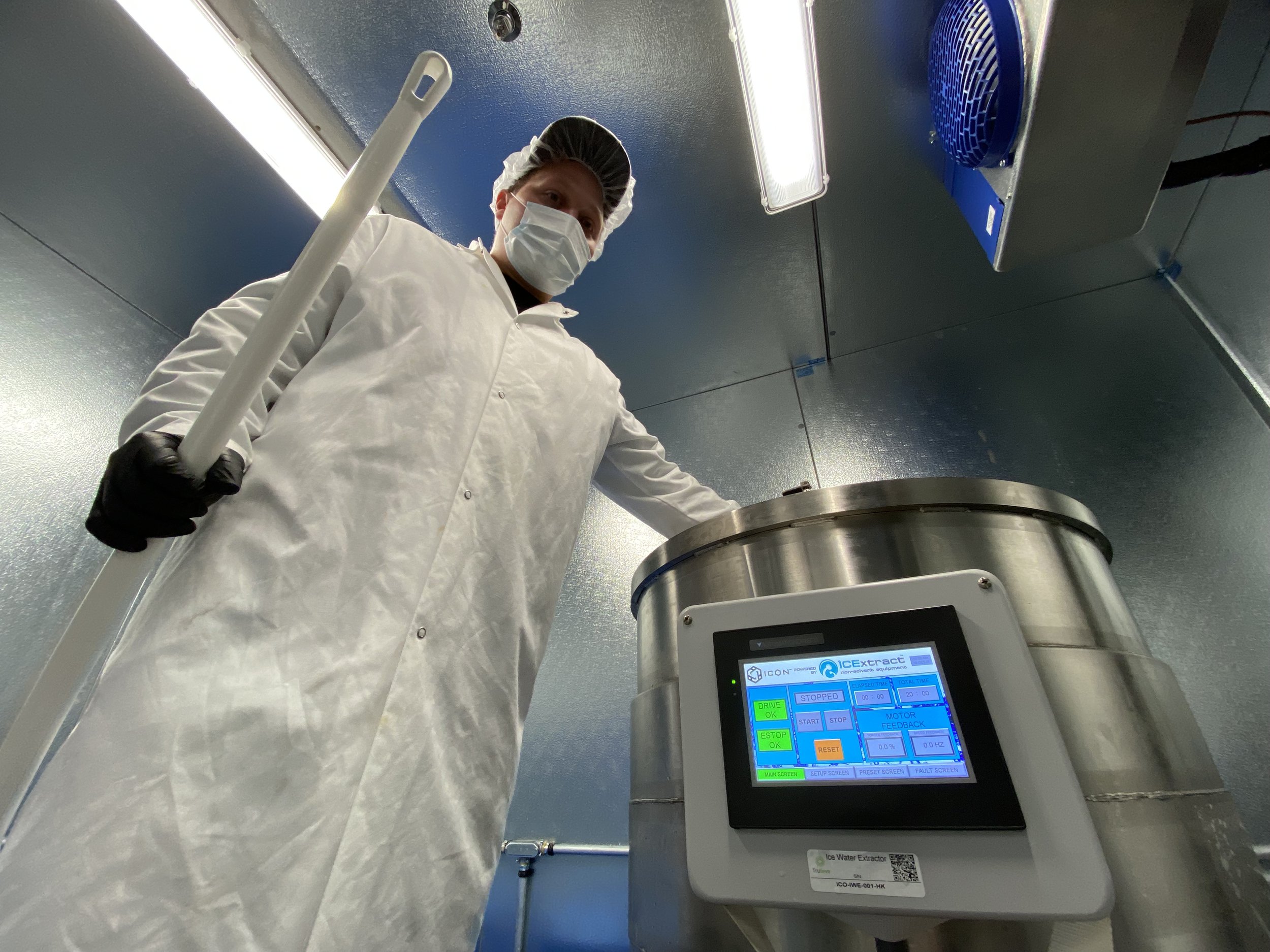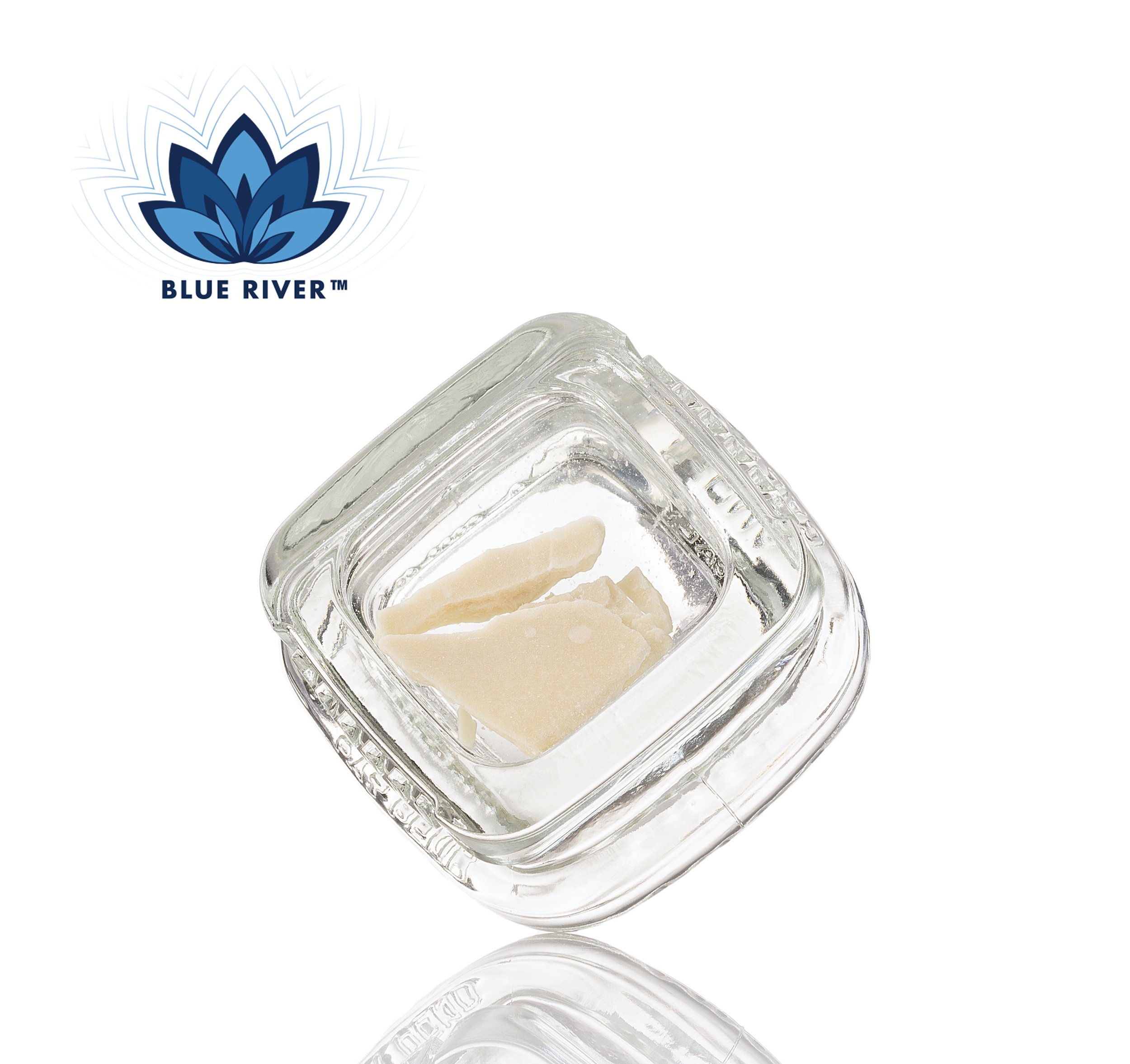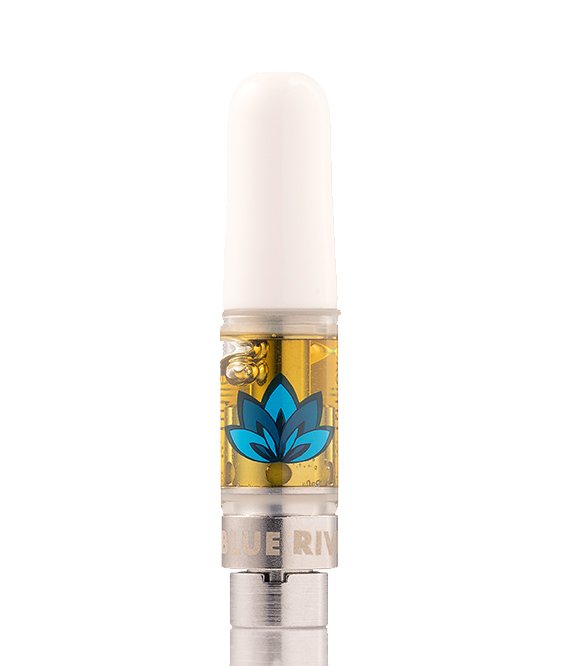A DEEP DIVE INTO CANNABIS TERPENES
Introduction
When you get a whiff of something and instinctively know it’s cannabis, it’s the plant's rich blends of terpenes that are responsible for letting your brain know what you’re smelling. Terpenes are part of a handful of important organic compounds that cannabis plants make alongside cannabinoids, flavonoids, as well as many others that when combined give our favorite strains their effects, aromas, and flavors. They’re mostly found in the cannabis plant’s trichomes, which are tiny pin-like structures that contain the majority of these prized molecules. At Blue River™, we believe that the best terpenes cannabis has to offer are expressed exclusively through solventless processing methods. That’s why every product we sell is made with only ice, water, gentle heat, and low pressure. To dive deeper into the world of terpenes, we’ll begin by exploring some of the actual chemistry behind them.
Terpene Science
Scientifically speaking, terpenes are organic unsaturated hydrocarbon molecules that are produced naturally by plants, fungi, and even animals but can also be synthetically derived as well. In many cases they can be highly volatile, meaning they are easily converted from liquids to gasses and thus disappearing. They can be ingested sublingually, topically, and of course through our bloodstream via vaporization. These incredible carbons, of which perhaps 20,000 or more are known to nature, create the distinct aromas of our favorite foods, flowers, trees, and much more. While one study indicates that there are at least 150 terpenes that have been discovered in cannabis, it seems likely that this number will grow as more research is conducted (Booth & Bohlmann, 2019) and more unique strains are bred. The term itself is credited to German chemist August Kekulé, who coined the word “terpene” in 1866 to avoid confusion with other similar hydrocarbon molecules, as previously they were known as camphenes (Kekulé, 1866).
There are technically multiple subclasses of terpenes based on their isoprene counts. The three most commonly found ones in cannabis are monoterpenes (C10H16), sesquiterpenes (C15H24), and diterpenes (C20H32). Monoterpenes contain two isoprene units and tend to be the most prevalent of the three in cannabis. Sesquiterpenes have three isoprene units and are commonly found in pheromones as defensive agents in plants. Finally, diterpenes, which contain four isoprene units, are the most known for their anti-inflammatory and antiseptic properties but are relatively rare. Scientific research has confirmed that terpenes offer a very wide range of medicinal benefits which are what underpin many folk medicines in addition to cannabis’s therapeutic effects.
In humans specifically, the reported effects of cannabis terpenes go all the way from the calming effects of linalool to the energizing effects of limonene, among many others. For limonene specifically, this may be why so many lemony cannabis strains tend to be sativas, as people frequently report an uplifting reaction from them. The aromas that terpenes create can be highly stimulating for everything from appetite to sleep but tend to be deeply personal. Interestingly enough, despite anecdotal evidence the often-cited synergistic entourage effect of terpenes and cannabinoids is actually more of an open-ended question as opposed to a scientifically confirmed fact. A recent peer reviewed study challenged conventional ideas on the matter by looking at the cannabinoid receptor reactions of five major terpenes, including myrcene, alpha and beta caryophyllene, pinene, as well as limonene. The researchers discovered that with the only exception being a weak CB2 interaction with b-caryophyllene, there was no measurable binding effect among the other terpenes with either THC or CBD (Finlay et al., 2020). What the authors concluded however was that the entourage effect can’t be directly explained by effects in our CB1 and CB2 cannabinoid receptors, and that more research is necessary to uncover the mysteries behind these complex neurological interactions. Whatever the case is, there is no doubt that certain strains make us feel certain ways, so there is still much to be discovered.
Terpenes in Nature
Terpenes are found across all of nature, and many share their namesakes with the plants that tend to produce them. Take alpha-pinene for example, which is the primary monoterpene responsible for imbuing the woody, uniquely “pine” scent that conifer species of trees give off on their bark and in their sap. From eucalyptus and eucalyptol to lemons and limonene, the list goes on and on. Fruits are another good case study in the power of terpenes found in nature. Most people tend to have certain fruits that they love as well as those that they don't, and those fruit’s terpenes play a major role in how appealing we may find them individually. There is no one “strawberry” terpene, but for those who love the fruit itself, their difficult to describe smell can be intensely appetizing. That strawberry smell is many different terpenes working in harmony, but it is the organic compound furaneol that gives it its particular aroma.
Many teas and herbs are also rich in terpenes in addition to fruits, but of course cannabis is the plant that has brought them to the forefront of many conversations. Another particularly interesting terpene found outside of cannabis is curcumin, which is the main active ingredient that is in turmeric roots and is famous for its health benefits. One study confirmed that the list of things curcumin may be useful for include all the following properties: anti-inflammatory, antioxidant, anticancer, antiseptic, anti-plasmodial, astringent, digestive, diuretic, and many other uses (Cox-Georgian et al., 2019).
Terpenes in Cannabis
The kaleidoscope of cannabis strains and their unique characteristics is truly fascinating – some smell exactly like fruits or desserts we love, and yet others can reek of straight gasoline. OGs, otherwise known as ocean grown strains which hail from California, usually have their whole own set of scents and effects that are especially desired by many connoisseurs. This level of variety is what makes the terpene combinations in cannabis so exciting. We pay extremely close attention to the terpenes in our products and carefully select the strains we use to make the best possible solventless options. Here are some of the most commonly found terpenes in cannabis.
Boiling Point (F)
Alpha-pinene is one of the most abundant terpenes in cannabis and is also found in savory herbs such as sage and rosemary. It is known to act as a natural bronchodilator and expectorant. It can help us focus better by increasing mental energy and can even act as a topical antiseptic.
Myrcene is found in menthol, lemongrass as well as most varieties of cannabis, and is widely used in the perfume industry. Myrcene has notable antimicrobial and antiseptic properties, too. It also acts as a natural antidepressant, anti-carcinogen and anti-inflammatory agent. It’s a relaxing substance and in cannabis-derived products and may increase cell membrane permeability, allowing for higher amounts of THC to travel to the brain.
Limonene, which is one of our favorite terpenes found in the cannabis strains, is also present in citrus fruits, juniper, and peppermint. It possesses anti-fungal, anti-bacterial, and anti-depressant effects. Moreover, it is suggested that this compound exerts anti-carcinogen properties and is known to have energizing effects.
Beta-caryophyllene is a common terpene found in the cannabis plant that has been scientifically proven to activate the CB2 receptor in the endocannabinoid system and also to exert anti-inflammatory effects. It provides a peppery smell, most commonly described as black pepper.
Linalool is a naturally occurring terpene alcohol chemical found in many flowers and spice plants with many commercial applications, the majority of which are based on its pleasant scent (floral, with a touch of spiciness). Linalool has a delicate aroma and tends to be one of the main terpenes that gives cannabis which contains it a flowery scent.
Humulene naturally occurs in clove, basil, hops, and many cannabis sativa lineages. It carries a subtle earthy, woody aroma with spicy herbal notes you might recognize in some of your favorite strains. Though cannabis is commonly associated with appetite stimulation, humulene is actually known to suppress hunger.
Ocimene is an isomeric hydrocarbon found in a wide variety of fruits and plants. It is recognized by its sweet, fragrant, herbaceous, and woodsy aromas, which feature prominently in several perfumes, and which help plants defend themselves in their natural environment. Ocimene occurs naturally in botanicals as diverse as mint, parsley, pepper, basil, mangoes, orchids, kumquats, and of course cannabis.
Terpinolene plays a key role in defining the taste and smell of many cannabis strains, even in minute quantities. Terpinolene’s aroma is more multidimensional than some other cannabis terpenes. Linalool smells like flowers. Limonene smells like citrus. Pinene? It smells like—surprise!—pine. Terpinolene, though, carries an array of smells: it’s piney, floral, herbaceous, and even a little citrusy all at the same time. One word that comes up often when describing terpinolene’s taste and smell is fresh. It’s part of the reason terpinolene shows up as an additive in soaps and perfumes. Like most terpenes, terpinolene isn’t unique to cannabis. It also shows up in lilacs, tea tree, nutmeg, cumin, and apples.
How Solventless Preserves Terpenes
Since terpenes are what give cannabis flowers, concentrates, vaporizers, and other products their unique aromas, their careful preservation from harvest to the customer is absolutely essential. Without proper care and handling, they quickly volatilize and are gone forever. Keeping them around isn’t easy to do, as only the artisanal solventless methods that we employ offer the purest expressions of the original strains the way they were meant to be enjoyed. At Blue River™, we only use freshly frozen cannabis buds which are harvested at the peak of their maturity for all our signature line of terpene-rich products, which are 100% solventlessly made. Most extractors rely on solvent-based methods however, where chemicals such as butane, propane, CO2, and alcohol are used to strip the essential oils of the cannabis plant out of it which are then reconstituted or purged to become consumable. This process of chemical dissolution is certainly the most efficient and cost-effective way for businesses to extract terpenes and cannabinoids but leaves a lot to be desired in the final product in terms of quality.
Solventless-based methods on the other hand have a similar end goal in mind but the opposite approach to get there – full preservation and isolation of the individual, delicate trichomes themselves, which are then mechanically as opposed to chemically expressed of their oils. Only by separating full spectrum terpenes from the plants without using solvents can you make the best of the best. This occurs through a few different methods but is mainly done by first gently washing fresh frozen cannabis in a bath of purified ice and water to separate the trichomes. They’re then filtered by size, graded for quality, and carefully freeze dried for maximum terpene preservation. Once the correct amount of moisture has been removed from the trichomes, they’re finally pressed with low heat within additional filtration so that the purest oil remains and the remaining organic plant matter that isn’t needed is left behind.
Terpenes in Blue River™ Products
Depending on the product, Blue River™ branded products are crafted from our proprietary advanced mechanical separation techniques, known as AMST, to create our Signature Live Rosin, Snow Rosin, Live Rosin Sauce, Jelly™ Sauce, Torrone, Hah Art, and Flan™ solventless textures. Even our edible lines of Rosin Capsules and Rosin Popping Boba contain premium solventless-extracted terpenes for a rich full spectrum effect not found in solvent-derived alternatives. Each product will contain different amounts of terpenes depending on its application and intended effects. While terpenes may be present in our products and vaporizers capturing authentic flavors and effects, they must be used carefully. Concentrated terpenes are a viscous liquid and at volumes above 20% can even be carcinogenic. That’s why there isn’t a single vaporizer, extract, or ingestible we sell that contains more than 18% terpenes by weight, which is well below that threshold. Each batch of all our products are laboratory tested to determine which terpenes are present in them at which concentrations right alongside all their cannabinoids and other compounds so that consumers know exactly what they’re getting with each farm-to-table experience.
Blue River's founder, Tony Verzura has demonstrated the versatility of terpenes and their various applications while building a brand built on purity, quality, and excellence.
“Terpenes can enhance the experience of variety goods from culinary and medical products, to aromatherapy and lifestyle products."
Tony Verzura is a veteran in solventless cannabis extraction technology, utilizing terpenes and cannabinoid sequencing in a variety of product lines that have reached thousands. Revered by many in the industry as a "cannabis alchemist," Verzura continues to innovate, pioneer, and popularize revolutionary techniques in the industry and apply these techniques to the Blue River™ brand.
References
Booth, J. K., & Bohlmann, J. (2019, July). Terpenes in Cannabis sativa – From plant genome to humans. ScienceDirect. https://www.sciencedirect.com/science/article/pii/S0168945219301190
Cox-Georgian, D., Ramadoss, N., Donna, C., & Basu, C. (2019, November 12). Therapeutic and Medicinal Uses of Terpenes - PMC. NCBI. https://www.ncbi.nlm.nih.gov/pmc/articles/PMC7120914/
Finlay, D. B., Sircombe, K. J., Nimick, M., Jones, C., & Glass, M. (2020, March 25). Terpenoids From Cannabis Do Not Mediate an Entourage Effect by Acting at Cannabinoid Receptors. Frontiers. https://www.frontiersin.org/articles/10.3389/fphar.2020.00359/full
Kekulé, A. (1866, August). Lehrbuch der organischen Chemie. Diccionario Cambridge Inglés y Tesauro gratuitos. https://books.google.com/books?id=IbBmZDznuPsC&pg=PA464#v=onepage&q&f=false






















